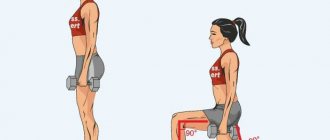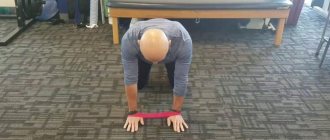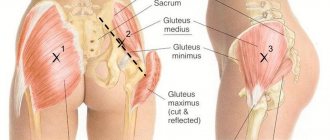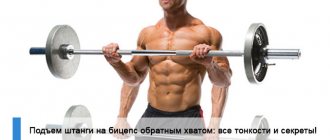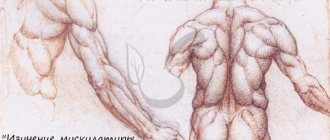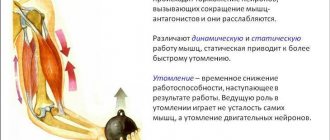Author: Timko Ilya - the ruler of the entire site and fitness trainer | more details >> Rod. 1984 Trained since 1999 Trained since 2007. Author and creator of the site tvoytrener.com. CCM in powerlifting. Champion of Russia and South Russia according to AWPC. Champion of the Krasnodar region according to IPF. 1st category in weightlifting. 2-time winner of the Krasnodar Territory championship in t/a. Author of more than 700 articles on fitness and amateur athletics. Author and co-author of 5 books.
Place in the author rating:
out of competition
(become an author)
Date:
2013-11-216
Views:
23,581
Rating:
5.0
| All articles by the author >> | Medals articles >> |
Articles are loading...
Hello. Probably many of you have heard about this method in bodybuilding. Now I will try to briefly define it.
The pre-fatigue method is when the target muscle group is specifically fatigued (hammered) with isolated exercises before performing the main exercise.
As most of you know, the classic scheme is when you do basic exercises, and after them, isolated ones.
Isolated exercises are exercises in which only the target muscle group or one muscle is worked.
Let's say the squat with a barbell is a basic exercise for the thigh muscles. And straightening your legs while sitting in a machine is already an isolated exercise.
That is, in the classical scheme, first we train the whole body, and then we work on specific muscles, “finishing off” them with isolated exercises. This option is quite logical from a physiological point of view.
But with the pre-fatigue method, everything is done the other way around. Let's say we first straighten our legs in the simulator, and only then go to squat. That is, we specifically tired the hip extensor muscles before squats. Where these same muscles also work. But in conjunction with other muscles.
Content
- 1 Pre-fatigue methods
- 2 Research
- 3 Practical approach 3.1 Complex for deltoid muscles
Video: pre-exhaustion
The purpose of pre-exhaustion is to load the target muscle with an isolation exercise, and then quickly move on to the basic exercise. If you look at it from a theoretical point of view, the idea is not bad, but it almost always doesn’t work out.
The maximum effect is achieved if the target muscle is very strong and cannot be penetrated by basic training alone. But the result will be much worse in the case when neither the insulating nor the base can reach the target area and it is not possible to direct the load to the right place.
A variation on the theme of pre-fatigue is “double split” training, which involves loading the target muscle at a time and in a situation when it is already tired. According to Ch. Poliquin, the best effect from muscle loading will be if you work with the target twice a day, or two days in a row.
In such a situation, the principle of constructing training with the inclusion of preliminary fatigue actually makes it possible to force a larger number of muscle fibers to work.
Pre-fatigue[edit | edit code]
This training method consists of preliminary fatigue of the target muscle (muscle group) using an isolation exercise, followed by a quick transition to performing a basic exercise. For example, you do light crossovers, trying to keep the load entirely on the pecs, and then move on to doing fairly heavy bench presses. Another combination: leg extensions and squats with a barbell on the shoulders (leg presses).
In theory, not bad. In practice, this is not always the case. In fact, this method works best on a muscle group that is very strong and which is very difficult to “break through” with just a basic movement. It is much worse suited in the case where neither basic nor isolating exercises can direct the load exactly to the right place.
One of the variations of the pre-fatigue method can be considered a “double split” - an approach to building a training program when the target muscle group is subjected to stress while already tired. Charles Poliquin argued that the greatest effect comes from training the same muscle group twice in one day (morning and evening), or two days in a row. The experience of the Baltic school of bodybuilding suggests the same thing - even during the existence of the Soviet Union, athletes from the Baltic states acquired huge arms by training them for two days in a row.
In this case, indeed, due to high preliminary fatigue, it is possible to involve a larger number of muscle fibers in the work. However, here too the best “response” will be in those muscle groups that cannot be called lagging behind. We need to find something that would allow us to use a larger number of muscle fibers, including (or primarily) in lagging muscles.
Pre-fatigue methods
Since training load is responsible for stimulating the growth of muscle cells, it helps the formation of certain biological factors. Namely, in the body there is an accumulation of free creatine, hydrogen ions, in muscle fibers that undergo training, and, of course, there is a high level of anabolic hormone in the blood and cells.
Tension in itself does not mean anything to the muscles, otherwise the loaders would be excellent bodybuilders. The result can only be achieved under optimal conditions; a certain intensity and duration are required. The duration of the load should correspond to what is required before the onset of muscle failure. There is no need to do less, much less more. Finding the golden mean is the task. But knowing the physiology of muscle tissue and the factors that can stimulate hypertrophy, you can more objectively assess a particular training load.
Pre-fatigue sets the task of performing an isolating exercise, which precedes the basic one, and the muscle group is the same. There are two ways to use pre-fatigue.
The first involves performing several sets of the same exercise, most often it is isolating. After this comes a series of complex sets. The second scheme implies high intensity, namely: the first exercise (one set), followed immediately without a break by the second (one set). The second concept allows you to significantly reduce training time; it fits organically into the concept of “limiting the amount of exercise”, which leads to stimulation of muscle growth.
The principle of training, which is based on preliminary fatigue, is advisable to use in the initial stages of training. Sometimes it can be useful for experienced athletes. For example, in a situation of injury, if it is not possible to work with the usual weights, then the blood that is pumped into the muscles will help heal the injury.
In order to choose the right pair of exercises in pre-exhaustion training, it is important to understand the basic scheme of its action. First, the isolating movement is turned on, then it is achieved with the basic one. The first most often involves the work of one joint or muscle group, while excluding the work of the rest. The basic one also has a target focus on the muscle being worked, but in addition to this, auxiliary ones are involved in the work. The success of performing the basic exercise is guaranteed by the not yet tired “assistants”, but at the same time the target muscle also works. This allows you to give her a killer load.
The best exercises to pre-fatigue muscles
One thing that is important to remember during pre-exhaustion is to load the muscle you are training that day as isolated as possible. In each repetition, the muscle must be stretched as much as possible and “squeezed” at the moment of peak contraction.
This not only helps pump more blood into the muscle, but also improves mental connection with the working muscles during subsequent basic exercises.
When working on hypertrophy, it is important to pay special attention to isolated training of the muscle group that interests you. Since you're only training it once a week, you need to create a fair amount of stress if your goal is to gain muscle mass.
Pectoral muscles: dumbbell fly on an incline bench
For most athletes, the upper chest is severely delayed in development. So why not work it out at the beginning of your workout?
Fully contract your muscles on each rep. After 2-3 approaches of the exercise, you will feel a strong pump. After this, move on to basic pressing exercises.
Back: pullover from the top block
It's not easy to isolate the latissimus dorsi, especially if you use your biceps to help you with every back exercise. To solve this problem, it is recommended to start every back workout with pullovers.
The pullover should be done specifically in a block simulator, since when working with a dumbbell, the load also falls on the pectoral muscles. After this exercise, move on to weighted pull-ups or heavy bent-over barbell rows.
Quadriceps: Partial Squats
Many people prefer to pre-exhaust their quadriceps with machine leg extensions, but this movement is not suitable for everyone. It is better to first load the quadriceps with quarter-amplitude squats.
Why only a quarter?
Deeper squats will target the entire mass of your legs, including your glutes and hamstrings.
So the next time you work out your legs at the gym, do a few quarter-range sets before you start doing full squats or leg presses.
Hamstrings: Ankle-locked sit-ups
The hamstrings are quite difficult to train in isolation, since most athletes pay much more attention to training the quadriceps. Therefore, in practice it is not so easy to apply the pre-fatigue method.
Ankle-locked sit-ups are not a complete isolation exercise, as they also work the buttocks and calf muscles. However, there is simply no better exercise for strong hamstrings.
It's great for pre-exhaustion if you're training your quadriceps and hamstrings on the same day.
Useful article: “How many repetitions and sets should you do for mass.”
Try doing a couple of sets of ankle-locked sit-ups in your next leg workout. You'll be surprised at how few reps you can do. But don't give up, this is a great exercise for developing the hamstrings, which serve as an antagonist to the quadriceps.
Shoulders: Swings with rubber band
Swings with a rubber band are ideal for pre-fatigue.
If you have a sedentary lifestyle, do a couple of sets of this exercise before each shoulder workout and feel the difference.
Upper cross or computer neck syndrome (where the head is pushed forward and the shoulders are rounded) is a common occurrence among office workers. Resistance band swings correct this problem.
By increasing shoulder mobility, you will be better able to perform shoulder pressing exercises that target all three deltoids. Be sure to do this exercise before every shoulder workout, and also as a warm-up before all other workouts.
Biceps: concentrated biceps curl
It is better to start training your biceps by performing one isolated exercise to get a feel for how it works.
Other types of biceps curls work your shoulders (and your back, if your form is that bad). Concentrated lifting is a completely different story. Perform this before moving on to basic movements like standing barbell curls.
Triceps: kickbacks on the lower block without handles
Big triceps = big arms. Therefore, it is advisable to pre-exert the triceps.
We all know how to do isolated triceps exercises. For preliminary fatigue, we recommend choosing kickbacks without a handle on the lower block. Grab the end of the cable and do bent over arm extensions. The block design puts constant tension on the triceps, and the absence of a handle makes the movement more natural. Do a couple of sets before moving on to close-grip bench presses or dips.
Calf muscles: single leg calf raise with your own weight
Everyone wants to have meaty calves, but no one wants to work hard to train them. Perform single calf raises without additional weights at the beginning of your workout to further stimulate muscle growth. This will allow you to better focus on the working muscles and pump as much blood as possible into your calves.
Research
At this time, among many published studies of this phenomenon, I would like to note the second. The first was carried out using the electromyography method; it demonstrated muscle activity during the execution of a particular exercise. The subjects squatted, but one group had a preload (extension of the quadriceps and lower legs), the other did not have such a load. As a result, the second group showed higher muscle activity when squatting. From this we can conclude that muscle hypertrophy depends on the tension and time during which they were loaded. This study showed that the use of pre-fatigue is inappropriate and this training strategy is incorrect.
The second exercise experiment involved the leg press. 17 men took part in it, some of them performed only the bench press, and the second part was a superset that combined the press and calf extension. Both did 10 repetitions until failure. The results of muscle activity were measured by an electromyograph. And they showed that the anterior thigh muscle was smaller during the preexhaustion superset, compared to the data that the athletes reported performing a single compound exercise. This means that by first tiring the quadriceps and then doing the basic exercise, athletes were able to use other muscles, and they take on the main load. As a result, the value of the barbell squat as a compound exercise is reduced when considering its benefits for the quadriceps. But when using anabolic steroids this is not so important. After all, the conditions for stimulating hypertrophy can be met, namely: free creatine accumulates, and its amount is quite large, since the active load continues for a long time. The concentration of lactic acid also increases, the use of anabolic hormones will allow them to have a high level anyway.
But those athletes who do not take anabolic steroids should be careful, because such a method will not lead to anything good.
Practical approach
If we look at specific practical examples, the standard scheme is called “pre-fatigue”. It involves performing an isolating exercise, followed by a basic one. The point of this technique is to preload the target muscle followed by a heavy load. As a result, the primary load will become the strongest for the muscle and will be able to break through each of its fibers.
Important! You should play it safe and do this training with an assistant. Since when approaching the basic exercise the main muscles are already tired, injury is likely.
But there is another option - changing the execution order. To begin with, with new strength, you begin basic training, stopping it one repetition before failure, then bring it to failure, but using a targeted load. As a result, you can get the same pre-fatigue (but at the expense of the base one). In this case, the risk of injury is significantly reduced.

